The fragile Muskari flower looks so unusual and comfortably that I want to certainly touch these little bells - touch the miracle. Magnificent sophisticated blue inflorescences are often used to improve compositions from colors and paintings of landscaped art. Muscari of different grades shows their tender buds in the spring, in April or May, and most of the year the onion of the plant "rest" under the ground.
Mouse hyacinth: Interesting facts about the name and system classification
Muscari - the name of the plant on Latin looks like. One-bedroom class, the separated department is the main "passport" data. But in the belonging of culture to a certain family of unequivocal opinion does not exist. According to the classic version, Muscari knows as part of the hyacinth family, and later classification recorded a flower to the Sparazhev family.
The Latin name was an unusual plant from the English nerd Miller, who assured that the smell of beautiful buds carries musky notes. In addition, the plant has many household titles: mouse hyacinth, puffy bow. The last name went to Hyacinth completely by chance - once people decided that the viper was powered by the leaves of Muscari, because the creep of the reptiles always noticed at the Hyacinth. Later it turned out that, being predators from nature, Vijuki was absolutely not interested in a flower as food. In fact, the snakes simply shuffle soaked in those well-lit places where hyacinth is growing. Muskari - Sun Child, and gladly decorates its presence Open Forest Polyany, thickets of shrubs, herbaceous slopes of mountains and steppe zones.
Mouse hyacinth plant was nicknamed for miniature and external similarity with a relative specimen. And the Europeans dubbed unusual bells with grape hyacinth, as we treated in it common features with a brush of grapes.
Plant distribution history
In the distant past, Muskari could be admired only in the rich gardens of eastern nobles, where he was loved and read the same as the tulip. Later, the beauty of the plant was rated by Osmans, Austrians and the Dutch, then, by the will of the case, Europeans learned about mouse hyacinth. In the 17th century The vessel, which was transported by the batch of Muskari Lukovizari, was crashed near the shores of Holland, and the spring unknown to local residents, but a very beautiful plant sprout along the entire length of the coastline - her seeds were brought there by sea waves. It happened in 1734, when the tulip was so pleased with the demanding tastes of the gardeners that they happily accepted Muscari as a new favorite.
Today, wild mouse hyacinth can be seen in Northern African countries and in the west of Asia. A huge number of species cultivated residents of the Mediterranean, and some varieties of the plant were borrowed by Australians and North American.
Mouse Hyacinth: General Botanical Information about Muskari
This herbaceous perennial is a large half of 12 months asleep. The stalk of a wounded plant is represented by a long bulb to 6 cm in height. For the synthesis of nutritional trace elements, it takes quite a bit of time, then she just waits for an hour under the ground. With the arrival of spring heat, Muskari will acquire leaves and flowers resembling stems. Mouse hyacinth grows up to 30 cm. Its beautifully curved leaves are collected in a root rosette, and the miniature colors bells form inflorescence in the form of a brush about 7 cm long. Flowers of mouse hyacinth are painted in blue and purple, and the pericheries contrast with them white, pink, dark blue and yellow shades.
Muscari for garden decoration
Today, mouse hyacinth found cultural use in landscape art. The flower compositions on the flower beds, alpine hills, rockers, and flower beds, which bloom continuously are perfect. Group landing of mouse hyacinth is particularly impressive when the juicy greenery of the lawn shall be selected. Wonderful neighbors for muscari can serve such flowers:
- crocuses;
- hionodoxes;
- daffodils;
- different types of tulips;
- ryabiki;
- hyacinths;
- primulus.
When combining mouse hyacinth with other plant species, one important nuance should be taken into account: the ground part of the Muscari after the end of flowering looks not so beautiful as before. This, by the way, the overall trait of all bulbous plants. To hide the unattractive type of fading mouse hyacinths, plants with a later period of flowering are planted in the common flower bed, the flowers will hide the emptiness in those places where Muskari was mocked quite recently. This task can be safely entrusted to lovely flocks, Yaskolkov, Astilbam and Hosts.
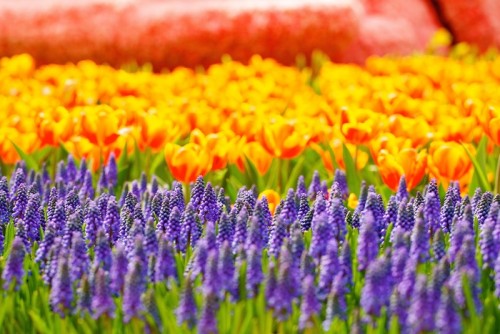
Another interesting way to give your own "highlight" in the form of a mouse hyacinth involves landing of a spectacular perennial near the trees, whose crowns will be decorated with leaves only after growing up muscari. Thus, the flower will hardly be almost the only bright spot of the spring garden.
Decorative qualities of mouse hyacinth are indisputable. In addition, the bully plant has established itself as a wonderful honey, thanks to which there will always be hardworking pedigrees of flower pollen - bees and bumblebees.
It will not be difficult to grow mouse hyacinth in a container, then the cheerful view of the bells of the plant will bring special spring freshness and comfort on open terraces and balconies. In Kashpo Muscari will be able to organically add Viol, Daisy and forget-me-not,.
How to grow a flower in the open soil
Being very beautiful and completely unassuming in the care of a cultural plant, mouse hyacinth acquired a lot of fans among domestic gardeners. Muscari on its plot is very simple.
Suitable location and soil
Flowers, of course, can grow in the shade, because absolutely not capricious, but still prefer open and well-lit areas that are constantly dominated by the sunny rays. The protection for the winter Muscari is not needed, individual rocks, such as broad-sized mouse hyacinth and mouse hyacinth, for successful growth need mulching. The plant condescendingly refers to the composition of the soil, therefore it will easily germinate in almost any conditions. A special chic and expressive acquires a blooming muscari if its refuge became an easy, saturated with a variety of organic substances Earth with acidity indicators from 5.8 to 6.5. So that the flower showed its beauty to the fully, the soil in front of it is enriched with a compost or humus (0.5 buckets per 1 m 2).
Features of planting plants
In one place, they plant from 10 to 30 bulbs Muskari. If you purchased the planting material not in a specialized store, but from the hands, do not forget to treat the bulbs of phytoosporin or any other fungicidal means to destroy the ubiquitous pests. Drop small wells up to 8 cm deep at a distance of 5 - 7 cm from each other. Lower into the bulbs of the mouse hyacinth into these holes and pour over the earth on top. The thickness of the soil layer above the bulb should be about 1.5 - 2 cm.
Sometimes practicing such a scheme: 1 m 2.earth land up to 100 -200 bulbs. For example, you decided to decorate your lawn with blue muscari. Carefully remove the turf soil layer (no more than 8 cm) from the site you need. Now burst ground, bring compost there, while monitoring the state of the soil layer so that the lawn surface remains smooth. Finally, put on the bulbs. As soon as they all turn out to be in their places, the turf of the lawn is placed in the former place and abundantly watered.
Care rules for mouse hyacinth
So that the Muskari you planted quickly and please you with your spectacular blooming view, provide them with a moderately wet substrate. Remember that staring water in the ground where mouse hyacinth lives, will lead to sad consequences - vulnerable bulbs will begin to rot, and the plant will eventually die. By the way, a plot for landing Muscari is best to choose exactly taking into account the unlucky plants to the "dead" water. This means that the territory, which in the spring or in rainy periods, at least sharply flooded with water for growing mouse hyacinth does not fit.
After the appearance of bright bells, the state of Muskari will depend on the degree of soil moisture - for this, the Earth is constantly moistened. 2 weeks after the start of the flowering of watering completely exclude. When the last leaves fade, the semi-dry land is the best shelter for mouse hyacinth.
Be sure to enrich the Earth with organic fertilizers - then abundantly blooming Muskari form real thickets on this site. If the house for mouse hyacinth became a container, the flower must certainly fertilize the liquid combined composition 1 time in 2 weeks for the time of the vegetative period.
On the soil that hides Muskari's bulbs, there should be no weeds - periodically delivering this site from a harmful dispersion and neatly loose the upper layer of the soil so that the plant is fully provided with oxygen.
If a group landing of mouse hyacinth has become an ornament for your lawn, a smooth flow of vegetation of the plant cannot be impaired by mugging grass. This illuminated act will lead to a strong grinding of bulbs, which over time will disappear at all. Create your lawn in order when the leaves of mouse hyacinth are fed and completely dried.
A very attractive plant in terms of Muskari's care is also considered because the flower is almost invulnerable to infectious diseases and malicious insects. But the voracious rodents are a real catastrophe for mouse hyacinth. From the invasion of tailed pests save ultrasound discharge devices, poisons and, of course, mousetrap.
Once every 4 years, the bulbs of the mouse hyacinth are evicted from the previous place and look for a new "dwelling". The bulbs can be easily discovered during the flowering period Muskari - then they are clearly designated in the ground. With the help of shovels, carefully remove the cuts of the curtains from the ground and without cleaning them from the Earth Koma to not harm the roots, transfer to a new place. At the end of the "moving", the Muskari is well. In case you are not difficult to determine where the plant bulbs grow after the vegetative period is completed, transfer them in autumn, and not during flowering.
When cute plant bells are flashing, be sure to cut off the buds. The greening seeds will certainly weaken the bulbs, and the plant's self-survey with penetration into sites where you did not plan to grow muscari, it is unlikely to arrange.
How to grow mouse hyacinth in the container
Muscari does not lose its high decorativeness even in cases where the scale of its landings are reduced to a small container area. If you decide to grow mouse hyacinth in this form, do drainage holes in decorative containers and plant bulbs in it. In the fall, partially jump the pot in the garden of the garden, and with the arrival of the spring, transfer it to an elegant porridge or neatly transform bulwing together with the ground to another, more beautiful, container. A good company is a blooming Muscari make up the chapherdies planted nearby.
After completing the blossom of the bulb in the pot, they jerk again in the open ground for further maturation to dig them only in the spring. When Muscari grows in a container, he needs more care - more frequent watering and feeding.
Features of pastures of mouse hyacinth
For growing muskari in a closed soil, choose the largest and most beautiful bulbs (from 5 to 10 cm in circle). After planting or digging, the planting material is treated with a fungicide (for example, a weak solution of potassium mangartage), and then dried at room temperature and leave until September in a cool and dry place (the temperature must be no more than + 20 0WITH). If you purchased bulbs in a flower shop, they do not need disinfecting processing.
So that mouse hyacinth began to grow in winter in a pot, you need to observe the optimal temperature for it. The plant will not be able to bloom if it is not pre-withstanding it at a temperature of + 2 0 C - + 5 0 S. On average, the time of planting of bulbs is determined from such a calculation: 3 - 4 months need to withstand Muscari in cool conditions, then give it 2 - 3 weeks for pastures.
When you define the desired flowering time, leave the bulbs buried in dry solid in cool conditions (+ 8 0 C - + 9 0 C) for a period of 30 to 35 days. Then reduce the temperature to + 5 0 C - for this, planting material can be transferred to the refrigerator. 2 weeks before the end of excerpts in cold conditions, the bulbs are planted into a container filled with wet soil. The planting material is not completely covered: it is necessary to immerse it in a nutritious and lightweight substrate only 2 cm, the rest should be outdoors. Do not forget to make a good drainage from the ceramzit, shards or small pebbles at the bottom of the pot.
After 2 weeks, the pots bring to a warm and well-lit place with a temperature of at least + 10 - 11 0 C, after 3 days it increases to 15 0 S. The cutting ground is moisturized evenly, trying not to wet the ground part of the bulb. The vegetative period of Muskari in the closed soil comes on average in 10-14 days.
Methods of breeding plant
Beautifully blooming perennial can be multiplied vegetative or seeds.
When using the vegetative properties of the plant "kids", removed from the maternal bulbs, searmed. In the wild, mouse hyacinth is easily and quickly applied to extensive territories precisely thanks to the vegetative method of reproduction. The most suitable time for such a procedure is September. Healthy daughters begin to bloom two years after rooting.
Some types of mouse hyacinth in wildlife breed not growing vegetatively, and self-sowing. For indulgent plants, this method of obtaining the offspring of gardeners is practically not used, because at best, Muskari will delight blossom only after 3 to 4 years after sowing. When the latest flowers fade, overwhelmed seeds gathered from the largest and most beautiful copies. In the fall, they are sowing them into an open land or a seedling container, closeing them to a depth of at least 1 cm. A good germination of seeds will provide your regular care: You remove weed grass in time, loosen the earth, follow the optimal level of humidity and fertilize the soil, then the seeds of the Mushying Hyacinth must necessarily germinate.

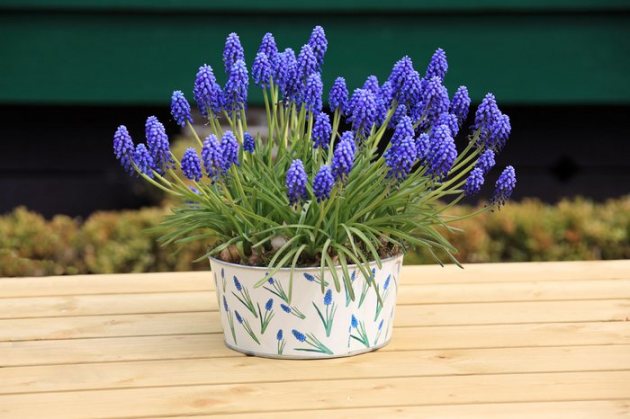
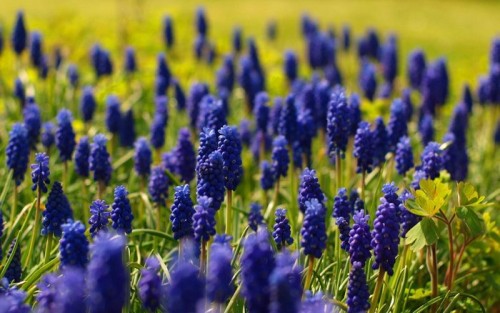
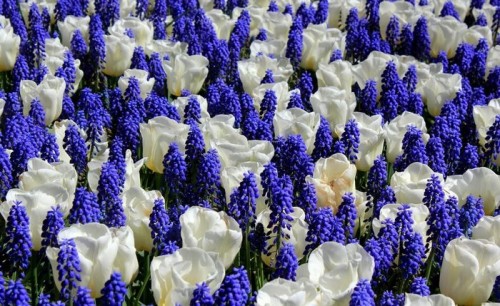
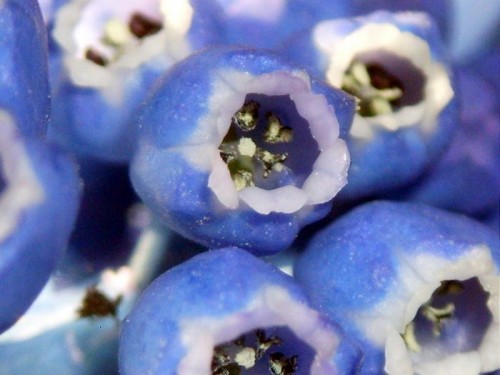

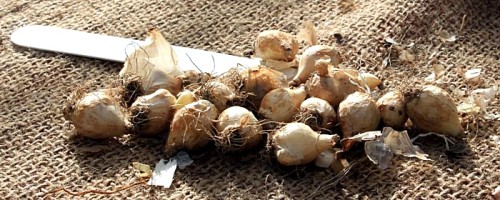
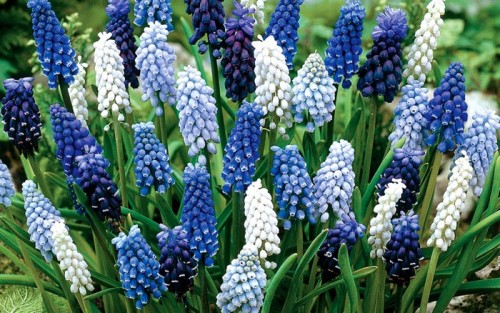
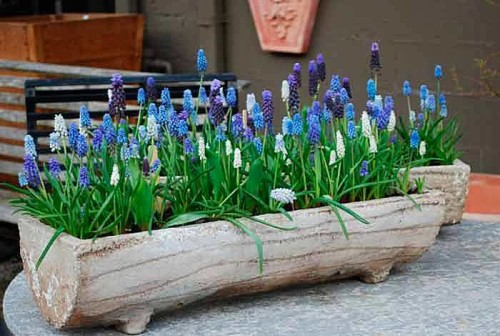

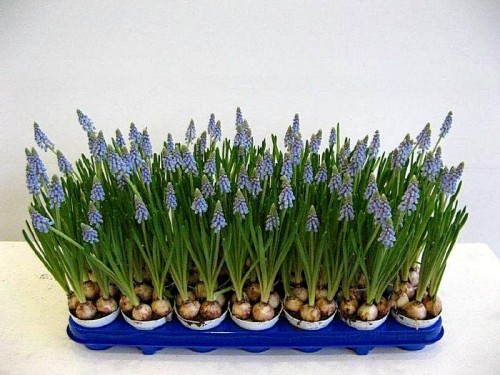












 Start a discussion ...
Start a discussion ...